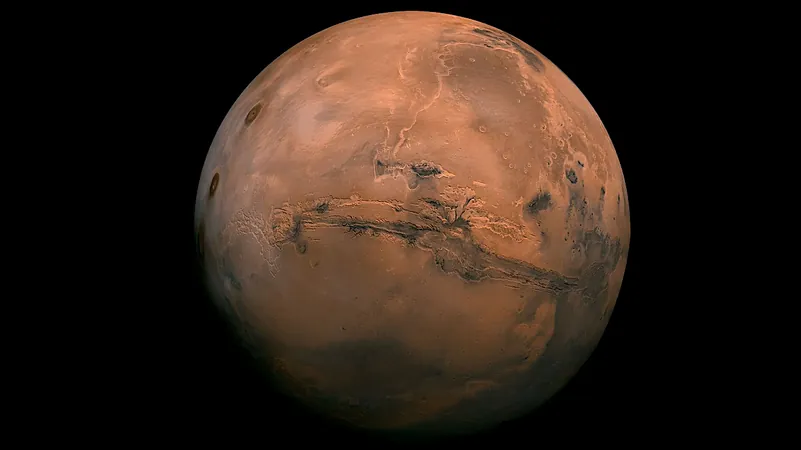
New Insights into Mars' Red Hue Point to a Potentially Habitable Ancient Climate
2025-04-06
Author: Noah
Introduction
A groundbreaking international study, partially funded by NASA, has shed new light on the enigmatic reasons behind Mars' iconic red color, providing compelling evidence that the Red Planet may have experienced a cooler but wetter climate in its ancient past. This discovery raises fascinating questions about the planet's capacity to support life millions of years ago.
Current Mars Conditions
Currently, Mars is characterized by a cold, thin atmosphere that makes it impossible for liquid water to persist on its surface. Despite this arid landscape, numerous NASA and international missions have uncovered signs that water once flowed abundantly across Mars, with features resembling dried-up rivers, lake beds, and minerals that indicate the presence of past water.
Ferrihydrite and Mars' Red Dust
The recent study, published on February 25 in the journal Nature Communications, posits that ferrihydrite — a water-rich iron mineral — is likely responsible for Mars' striking red dust. This finding adds a crucial piece to the puzzle, suggesting that the planet's reddish hue comes from a mineral that forms in cooler conditions, potentially creating an environment capable of sustaining liquid water before Mars transitioned into its present dry state billions of years ago.
Research Insights
Lead author Adam Valantinas, a postdoctoral fellow at Brown University, emphasized the importance of this research: “The fundamental question of why Mars is red has intrigued scientists for centuries. Our analysis proposes that ferrihydrite is pervasive in the dust and possibly within rock formations. While previous studies have mentioned ferrihydrite, our work allows for enhanced analysis using observational data and innovative laboratory techniques to replicate Martian dust.
Geronimo Villanueva, co-author and Associate Director for Strategic Science at NASA's Goddard Space Flight Center, pointed out that these findings hint at a potentially habitable past for Mars. This underscores the significance of collaboration between NASA and international agencies in unraveling critical mysteries about our solar system and guiding the future of exploration.
Methodology
The researchers conducted a comprehensive analysis using data from various Mars missions, combining observations from NASA's Mars Reconnaissance Orbiter and European Space Agency's Mars Express and Trace Gas Orbiter with ground-level measurements from rovers including Curiosity and Opportunity. Detailed spectral data collected from these instruments allowed the team to explore how light interacts with ferrihydrite particles and other minerals under simulated Martian conditions.
Future Exploration
Valantinas stated, “Our goal is to comprehend the ancient Martian climate and the chemical processes not just of the past but also those active today. We also aim to address the habitability question — specifically, whether life ever existed on Mars. Understanding the conditions during the formation of these minerals is essential for answering that question.
The findings indicate that ferrihydrite's formation required conditions significantly different from today's Martian environment, suggesting that the interaction of oxygen and water with iron was prevalent millions of years ago. As winds on Mars disperse this dust, they contribute to the planet's distinctive red appearance.
Whether the researchers’ theories regarding mineral formation are accurate can ultimately be validated after the Perseverance rover collects samples from Mars and returns them to Earth for analysis. “This study opens the door to further exploration,” remarked Jack Mustard, a senior author from Brown University. “As we await the return of samples from Mars, we can cross-examine our mineral formation principles with actual Martian materials, providing deeper insights into our neighbor planet’s history.
Conclusion
As space agencies prepare for a future where we can directly analyze Martian soil samples, the excitement surrounding potential discoveries about life beyond Earth continues to grow. The challenge now lies in how we leverage these findings to inform upcoming missions, enhancing humanity’s understanding of the cosmos.









 Brasil (PT)
Brasil (PT)
 Canada (EN)
Canada (EN)
 Chile (ES)
Chile (ES)
 Česko (CS)
Česko (CS)
 대한민국 (KO)
대한민국 (KO)
 España (ES)
España (ES)
 France (FR)
France (FR)
 Hong Kong (EN)
Hong Kong (EN)
 Italia (IT)
Italia (IT)
 日本 (JA)
日本 (JA)
 Magyarország (HU)
Magyarország (HU)
 Norge (NO)
Norge (NO)
 Polska (PL)
Polska (PL)
 Schweiz (DE)
Schweiz (DE)
 Singapore (EN)
Singapore (EN)
 Sverige (SV)
Sverige (SV)
 Suomi (FI)
Suomi (FI)
 Türkiye (TR)
Türkiye (TR)
 الإمارات العربية المتحدة (AR)
الإمارات العربية المتحدة (AR)